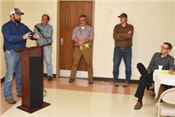|
North Louisiana Farmers Eyeing Row Rice More Closely

Morehouse Parish rice farmer Jason Waller, far left, talks at the Northeast Louisiana Rice Forum about his experiences
growing row rice. Looking on are, left to right, Scott Franklin, president of the Northeast Louisiana Rice Growers Association; Michael Costello, who farms in Franklin and Morehouse parishes; Elliot Colvin, who farms in Richland Parish; and Don Groth, resident coordinator of the LSU AgCenter H. Rouse Caffey Rice Research Station.
Photo by Bruce Schultz/LSU AgCenter
RAYVILLE, LA.
Farmers at the Northeast Louisiana Rice Forum on Feb. 4 heard about the benefits and challenges of growing row rice.
The practice uses irrigation with poly pipe or rainwater to keep soil moist, but no permanent flood is maintained. Levees are not required, so farmers can wait until planting to make crop decisions.
Mike Salassi, LSU AgCenter associate vice president for plants, soils and water resources, said research by the LSU AgCenter for row rice has been increased.
The Louisiana Rice Research Board has approved three projects related to the row rice practice. The projects cover fertilization, fungicides and best management practices.
Three north Louisiana farmers detailed their experiences with growing row rice.
Morehouse Parish farmer Jason Waller, a member of the Louisiana Rice Research Board, said all of his rice is grown using the row rice method. It provides more flexibility at planting time, and because no levees are required, it’s more convenient. “If you don’t have to deal with levees, you are ahead,” he said.
Michael Costello, who farms in Franklin and Morehouse parishes, agreed. “I hope I never see another levee plow again,” he said.
Costello said he made an implement to create grooves in the soil to help drainage.
Hybrids are recommended for row rice, but Costello said he has made good crops with conventional varieties. However, frequent scouting is required. “I took a chance and it worked,” he said.
Waller said water consumption decreased by 25% on his row rice fields. Irrigation is done every four days with poly pipe, and it takes about 12 hours to water a field.
Waller said he had been planting rice on 38-inch beds with 9-inch row spacing, but he has changed to 30-inch beds with 7-inch spacing. The narrow spacing provides better weed control because the crop canopy closes sooner, he said.
Elliot Colvin, of Richland Parish, said he never allows his soil to dry and crack before watering. He said some of his fields would not hold water, but yields were not affected.
Colvin advised anyone considering row rice to plant half as much as they are considering. “There’s a learning curve to it,” he said.
Waller planted 40 acres his first year. He increased to 200 to 300 acres the second year and 900 acres in the third year. Last year he had all of his 2,000 acres in row rice.
Costello said he planted about 1,300 acres of the Jupiter variety using the row rice technique. “It’s got a place, and it’s here to stay,” he said.
Moisture meters can be used to determine when a crop needs water, but the devices are expensive, said AgCenter agent Keith Collins.
Waller said the meters underestimate the water needs of row rice. “If that moisture meter is telling you it’s time to water, you’re two days late,” he said.
AgCenter plant pathologist Don Groth said disease plagued Louisiana rice farmers last year.
Smut disease Louisiana affected many fields in south Louisiana. “We had loads of rice rejected at the scales because of bad smut,” he said.
Spraying fungicides for smuts should be done with a 2- to 4-inch head in the boot stage, he said.
Blast disease is often found in fields with sandy soil that drain quickly and in fields lined by trees.
Fungicide applications should be made earlier on fields that have been planted late, Groth said.
He reminded farmers that fungicides prevent diseases. “None of these fungicides are curative,” he said.
Bacterial panicle blight occurs in hot, dry conditions. “Once it develops, we can’t do anything about it,” Groth said.
The new Provisia variety PVL02 has improved yield and better blast resistance than PVL01, he said.
A new Clearfield variety, CLL17, has good yielding potential and disease resistance.
AgCenter entomologist Sebe Brown said billbugs were found in Tensas Parish. They are often found once damage has occurred after rice has headed. “If you’re growing row rice, be on the lookout for these guys,” he said.
The insects cannot survive a permanent flood.
Brown will be testing seed treatment products, including Dermacor, for controlling billbugs.
This insect probably overwinters near trees and tree lines. “Field edges closer to tree lines seem to be the worst,” he said.
Brown also said the Fortenza insecticide has shown good efficacy against rice water weevils, but research on Fortenza’s efficacy against other rice pests is ongoing.
Pyrethroids can be used on stem borers when they first infest a field, and frequent scouting should be done for the insect pests. “Once they make it into the stalks, there’s nothing you can do,” he said.
Brown also cautioned farmers against using acephate on rice insect pests because the insecticide is not labeled for rice.
AgCenter economics research associate Brian Hilbun said rice prices could increase. Rice production decreased in the U.S. last year, and ending stocks declined by 36 percent.
More Latin American countries are buying American rice again. “We are at or above last year’s pace for exports to Mexico,” he said.
Also at the meeting:
Lydia Holmes, of USA Rice, gave an overview of the rice sustainability project and the Rice Leadership Program. ∆
|
|